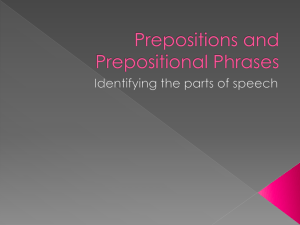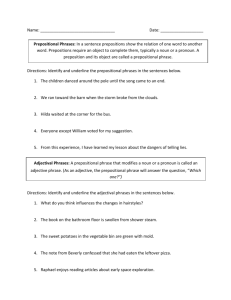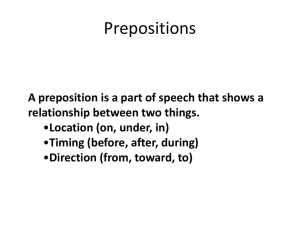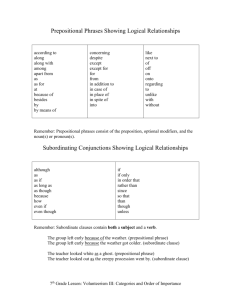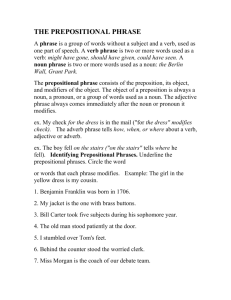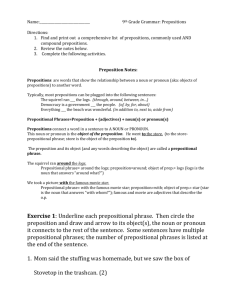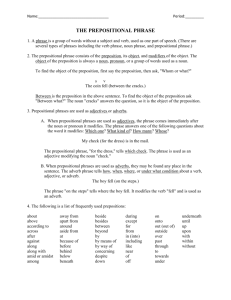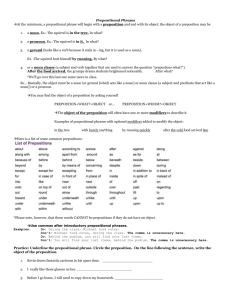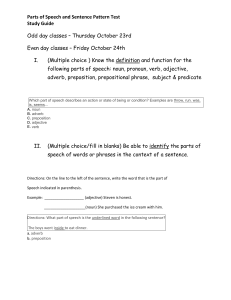Recognizing Prepositional Phrases
advertisement
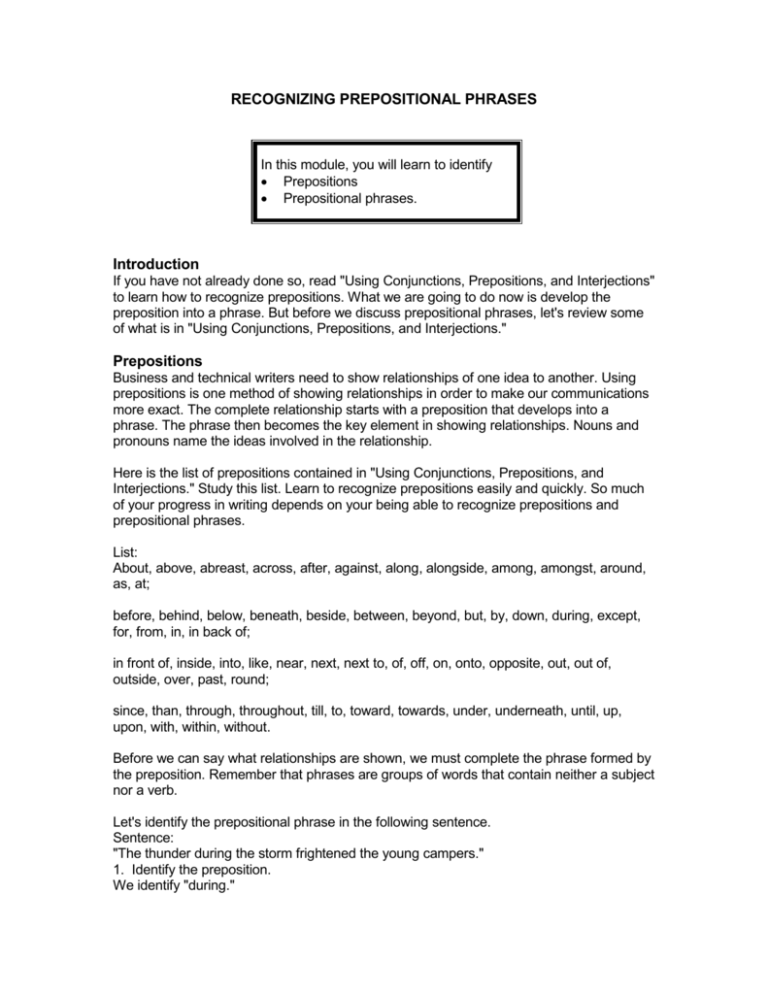
RECOGNIZING PREPOSITIONAL PHRASES In this module, you will learn to identify Prepositions Prepositional phrases. Introduction If you have not already done so, read "Using Conjunctions, Prepositions, and Interjections" to learn how to recognize prepositions. What we are going to do now is develop the preposition into a phrase. But before we discuss prepositional phrases, let's review some of what is in "Using Conjunctions, Prepositions, and Interjections." Prepositions Business and technical writers need to show relationships of one idea to another. Using prepositions is one method of showing relationships in order to make our communications more exact. The complete relationship starts with a preposition that develops into a phrase. The phrase then becomes the key element in showing relationships. Nouns and pronouns name the ideas involved in the relationship. Here is the list of prepositions contained in "Using Conjunctions, Prepositions, and Interjections." Study this list. Learn to recognize prepositions easily and quickly. So much of your progress in writing depends on your being able to recognize prepositions and prepositional phrases. List: About, above, abreast, across, after, against, along, alongside, among, amongst, around, as, at; before, behind, below, beneath, beside, between, beyond, but, by, down, during, except, for, from, in, in back of; in front of, inside, into, like, near, next, next to, of, off, on, onto, opposite, out, out of, outside, over, past, round; since, than, through, throughout, till, to, toward, towards, under, underneath, until, up, upon, with, within, without. Before we can say what relationships are shown, we must complete the phrase formed by the preposition. Remember that phrases are groups of words that contain neither a subject nor a verb. Let's identify the prepositional phrase in the following sentence. Sentence: "The thunder during the storm frightened the young campers." 1. Identify the preposition. We identify "during." So we know we have the start of a prepositional phrase. 2. Identify the noun or pronoun that ends the prepositional phrase. We start with "during" and keep reading. We encounter "the," but we know that "the" is an adjective. We keep reading and encounter "storm," a noun. We know the phrase must end on a noun or a pronoun, so we stop. 3. Identify the prepositional phrase. We identify "during the storm." "Storm," a noun, ends the prepositional phrase. Thus, "storm" is one of the nouns/pronouns in the relationship. Now we must identify the other noun/pronoun with which "during the storm" creates a relationship. This is the easier part. Ask: Who or what during the storm? Answer: The thunder during the storm. So there you have it. The relationship created by the preposition "during" is a relationship of time between the "storm" and the "thunder." In other words, the "thunder" we are concerned with is not the "thunder" after the storm, nor before the storm, nor since the storm, nor even throughout the storm. We are talking about the thunder DURING the storm. Let's try another. Sentence: "The carpet between the desk and the wall was very worn." 1. Identify the preposition. We identify "between." 2. Identify the noun or pronoun that ends the prepositional phrase. We start with "between" and keep reading. We encounter "the" and recognize it as an adjective. So we keep reading and encounter "desk." But after "desk," we encounter a conjunction. So we can't stop (because a conjunction joins things); we must continue to join things. 3. Identify the prepositional phrase. We continue past "desk" and find that the conjunction "and" joins "the desk" to "the wall." We continue past "wall," and find the verb "was." So we stop. We've reached the end of the prepositional phrase. We recognize the prepositional phrase ending with the noun "wall." We recognize "between the desk and the wall," as a prepositional phrase showing a relationship of space between the carpet and the desk and the wall. Let's try one more example. Sentence: "In the fading light of day, the young voices joined with us for one last song." 1. Identify the preposition. We identify "in." 2. Identify the noun or pronoun that ends the prepositional phrase. We start with in and keep reading. We encounter "the" and "fading," which we recognize as adjectives; so we keep reading until we encounter "light." We identify light as the end of the prepositional phrase because "light" is a noun and a preposition follows. We have identified one prepositional phrase: "In the fading light." We recognize another preposition, "of." We go through our procedure and identify one more prepositional phrase: "of day." We recognize yet another preposition, "with." We identify a third prepositional phrase: "with us." "Us" is a pronoun that can end a prepositional phrase in the same way a noun can. We continue reading, and we encounter still another preposition, "for." We continue reading. "One" is an adjective in this sentence, "last" another adjective. Then we encounter the last word in the sentence, the noun "song," and we've reached the end of this prepositional phrase. So in this last sentence "In the fading light of day, the young voices joined with us for one last song," we identified four prepositional phrases: in the fading light of day with us for one last song. Try the sentence that follows. How many prepositional phrases can you identify? The answer is at the end of this instructional lesson. Sentence: "One of the nicest things about college is the way the instructors allow the students to decide on the direction their education will take." A word of caution: Be careful in identifying "to." "To" plus an action (to run) is a noun. If an action follows "to," then "to" is not a preposition. If a noun or a pronoun follows "to," then "to" is a preposition. For example, in "to study," study is an action, so "to" is not a preposition. In "to school," school is a noun, so "to" is a preposition. In "to him," him is a pronoun, so "to" is a preposition. Also, be careful with words such as "as, before, for, since, than, until." These common words and a few more can serve as either prepositions or conjunctions. For example, if a noun or a pronoun follows, these words are prepositions, and prepositional phrases are created. But if a subject and a verb follow, these words are conjunctions, and clauses are created. Study the examples that follow. The word group "AS ice" is a prepositional phrase. The word group "AS he ran for the goal line" is a clause. The word group "BEFORE dawn" is a prepositional phrase. The word group "BEFORE we ate dinner" is a clause. The word group "FOR her journey" is a prepositional phrase. The word group "FOR she had no transportation" is a clause. So analyze the structure of the word group before deciding on part-of-speech labels for the individual words. Review A preposition is a word that shows a relationship between nouns, between pronouns, or between nouns and pronouns. A prepositional phrase completes the relationship started by the preposition. A preposition starts a prepositional phrase. A prepositional phrase must end with a noun or a pronoun. A prepositional phrase may contain any number of nouns or pronouns. "To" plus an action (to run) is always a noun, never a prepositional phrase. If a noun or pronoun follows "to," then "to" is a preposition. Some words can be either prepositions or conjunctions. If a subject and a verb follow, the word is a conjunction. If a noun or pronoun follows, the word is a preposition. Sentence: "One of the nicest things about college is the way the instructors allow the students to decide on the direction their education will take." Answer for number of prepositional phrases: 1. of the nicest things 2. about college 3. on the direction. If you identified four prepositional phrases, you probably incorrectly included "to decide." Exercises Analyze the following sentences and then select the statement that is incorrect. The answers appear after the last question. 1. Suneeta's friends took pride in her talents and hoped she would become a famous singer. A. Her is a preposition. B. And is not a preposition. C. In her talents is a prepositional phrase. D. A famous singer is not a prepositional phrase. 2. None of the floats in our parade had a marine theme. A. Of is a preposition. B. The is not a preposition. C. Of the floats is a prepositional phrase. D. In our parade is not a prepositional phrase. 3. Everybody in the room knew he had been happy during his childhood. A. In is a preposition. B. His is not a preposition. C. In the room is a prepositional phrase. D. During his childhood is not a prepositional phrase. 4. All of the bridges crossing the river were severely damaged by the storm. A. The is a preposition. B. All is not a preposition. C. By the storm is a prepositional phrase. D. Crossing the river is not a prepositional phrase. 5. Along the street, children and their parents waited for the rock star to drive past. A. Their is a preposition. B. And is not a preposition. C. Along the street is a prepositional phrase. D. To drive past is not a prepositional phrase. 6. Alongside the mayor on the stage stood his beaming wife. A. Alongside is a preposition. B. On the stage is not a prepositional phrase. C. Alongside the mayor is a prepositional phrase. D. Beaming is not a preposition. 7. Ravinder quickly turned into the bookstore next to the cafe. A. Into is a preposition. B. Next to is not a preposition. C. Next to the cafe is a prepositional phrase. D. Quickly turned is not a prepositional phrase. 8. All of the proposed dates for the meeting were acceptable to them. A. For is a preposition. B. All is not a preposition. C. To them is not a prepositional phrase. D. Of the proposed dates is a prepositional phrase. 9. Before the exam, Farook found his pen amongst the books under the table. A. Before is a preposition. B. His is not a preposition. C. Amongst his books is a prepositional phrase. D. Under the table is not a prepositional phrase. 10. Around sunset, the condition of the roads in the city improved for a while. A. Of is a preposition. B. Around is not a preposition. C. In the city is a prepositional phrase. D. The condition is not a prepositional phrase. Answers 1, A. 2, D. 3, D. 4, A. 5, A. 6, B. 7, B. 8, C. 9, D. 10, B.
